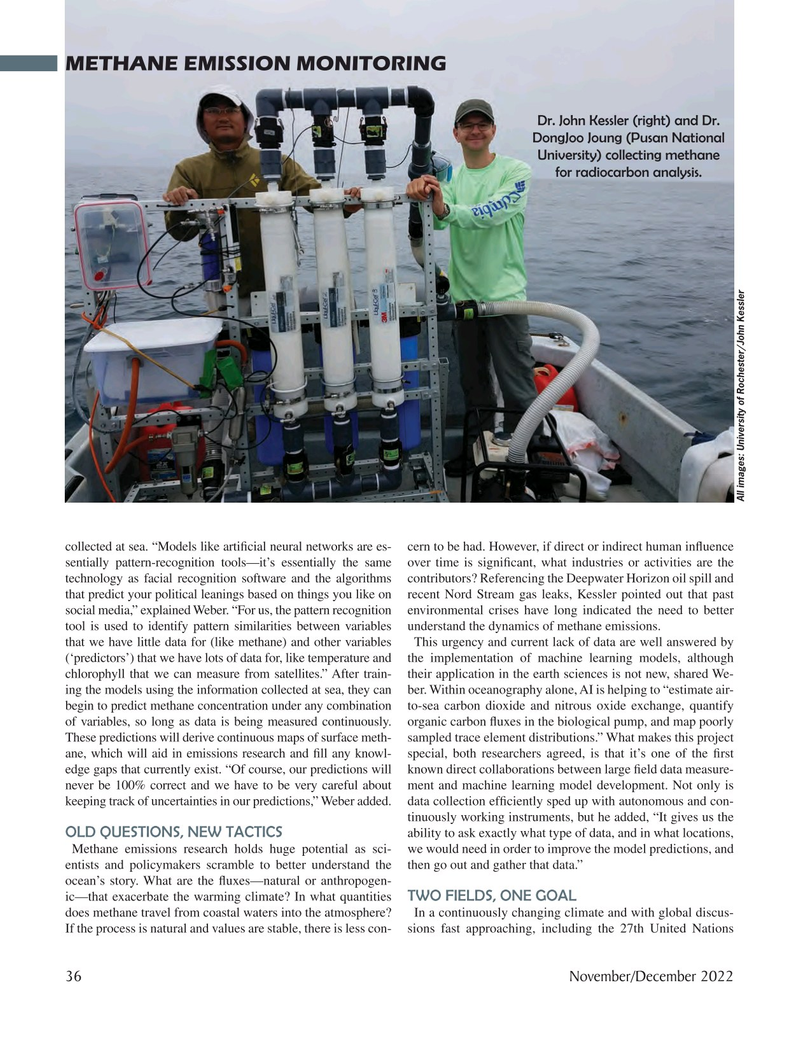
Page 36: of Marine Technology Magazine (November 2022)
Read this page in Pdf, Flash or Html5 edition of November 2022 Marine Technology Magazine
METHANE EMISSION MONITORING
Dr. John Kessler (right) and Dr.
DongJoo Joung (Pusan National
University) collecting methane for radiocarbon analysis.
All images: University of Rochester/John Kessler collected at sea. “Models like arti? cial neural networks are es- cern to be had. However, if direct or indirect human in? uence sentially pattern-recognition tools—it’s essentially the same over time is signi? cant, what industries or activities are the technology as facial recognition software and the algorithms contributors? Referencing the Deepwater Horizon oil spill and that predict your political leanings based on things you like on recent Nord Stream gas leaks, Kessler pointed out that past social media,” explained Weber. “For us, the pattern recognition environmental crises have long indicated the need to better tool is used to identify pattern similarities between variables understand the dynamics of methane emissions. that we have little data for (like methane) and other variables This urgency and current lack of data are well answered by (‘predictors’) that we have lots of data for, like temperature and the implementation of machine learning models, although chlorophyll that we can measure from satellites.” After train- their application in the earth sciences is not new, shared We- ing the models using the information collected at sea, they can ber. Within oceanography alone, AI is helping to “estimate air- begin to predict methane concentration under any combination to-sea carbon dioxide and nitrous oxide exchange, quantify of variables, so long as data is being measured continuously. organic carbon ? uxes in the biological pump, and map poorly
These predictions will derive continuous maps of surface meth- sampled trace element distributions.” What makes this project ane, which will aid in emissions research and ? ll any knowl- special, both researchers agreed, is that it’s one of the ? rst edge gaps that currently exist. “Of course, our predictions will known direct collaborations between large ? eld data measure- never be 100% correct and we have to be very careful about ment and machine learning model development. Not only is keeping track of uncertainties in our predictions,” Weber added. data collection ef? ciently sped up with autonomous and con- tinuously working instruments, but he added, “It gives us the ability to ask exactly what type of data, and in what locations,
OLD QUESTIONS, NEW TACTICS
Methane emissions research holds huge potential as sci- we would need in order to improve the model predictions, and entists and policymakers scramble to better understand the then go out and gather that data.” ocean’s story. What are the ? uxes—natural or anthropogen- ic—that exacerbate the warming climate? In what quantities TWO FIELDS, ONE GOAL does methane travel from coastal waters into the atmosphere? In a continuously changing climate and with global discus-
If the process is natural and values are stable, there is less con- sions fast approaching, including the 27th United Nations 36 November/December 2022
MTR #8 (34-49).indd 36 11/29/2022 3:39:53 PM

 35
35

 37
37
